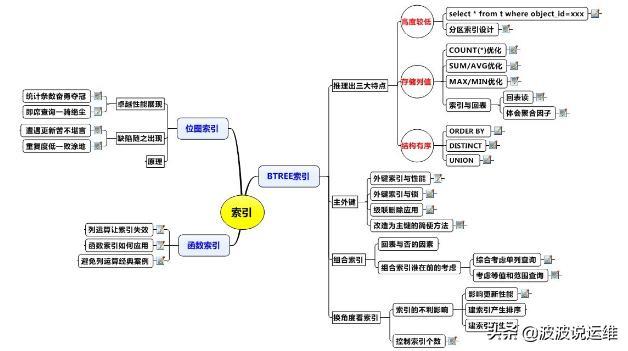今天就跟大家聊聊有关Oracle数据库中有哪些索引类型,可能很多人都不太了解,为了让大家更加了解,小编给大家总结了以下内容,希望大家根据这篇文章可以有所收获。

一、B-Tree索引
三大特点:高度较低、存储列值、结构有序
1. 利用索引特性进行优化
外键上建立索引:不但可以提升查询效率,而且可以有效避免锁的竞争(外键所在表delete记录未提交,主键所在表会被锁住)。
统计类查询SQL:count(), avg(), sum(), max(), min()
排序操作:order by字段建立索引
去重操作:distinct
UNION/UNION ALL:union all不需要去重,不需要排序
2. 联合索引
应用场景一:SQL查询列很少,建立查询列的联合索引可以有效消除回表,但一般超过3个字段的联合索引都是不合适的.
应用场景二:在字段A返回记录多,在字段B返回记录多,在字段A,B同时查询返回记录少,比如执行下面的查询,结果c1,c2都很多,c3却很少。
select count(1) c1 from t where A = 1; select count(1) c2 from t where B = 2; select count(1) c3 from t where A = 1 and B = 2;
联合索引的列谁在前?
普遍流行的观点:重复记录少的字段放在前面,重复记录多的放在后面,其实这样的结论并不准确。
drop table t purge; create table t as select * from dba_objects; create index idx1_object_id on t(object_id,object_type); create index idx2_object_id on t(object_type,object_id);
等值查询:
select * from t where object_id = 20 and object_type = 'TABLE'; select /*+ index(t,idx1_object_id) */ * from t where object_id = 20 and object_type = 'TABLE'; select /*+ index(t,idx2_object_id) */ * from t where object_id = 20 and object_type = 'TABLE';
结论:等值查询情况下,组合索引的列无论哪一列在前,性能都一样。
范围查询:
select * from t where object_id >=20 and object_id < 2000 and object_type = 'TABLE'; select /*+ index(t,idx1_object_id) */ * from t where object_id >=20 and object_id < 2000 and object_type = 'TABLE'; select /*+ index(t,idx2_object_id) */ * from t where object_id >=20 and object_id < 2000 and object_type = 'TABLE';
结论:组合索引的列,等值查询列在前,范围查询列在后。 但如果在实际生产环境要确定组合索引列谁在前,要综合考虑所有常用SQL使用索引情况,因为索引过多会影响入库性能。
3. 索引的危害
表上有过多索引主要会严重影响插入性能;
对delete操作,删除少量数据索引可以有效快速定位,提升删除效率,但是如果删除大量数据就会有负面影响;
对update操作类似delete,而且如果更新的是非索引列则无影响。
4. 索引的监控
--监控 alter index [index_name] monitoring usage; select * from v$object_usage; --取消监控: alter index [index_name] nomonitoring usage;
根据对索引监控的结果,对长时间未使用的索引可以考虑将其删除。
5. 索引的常见执行计划
INDEX FULL SCAN:索引的全扫描,单块读,有序
INDEX RANGE SCAN:索引的范围扫描
INDEX FAST FULL SCAN:索引的快速全扫描,多块读,无序
INDEX FULL SCAN(MIN/MAX):针对MAX(),MIN()函数的查询
INDEX SKIP SCAN:查询条件没有用到组合索引的第一列,而组合索引的第一列重复度较高时,可能用到
二、位图索引
应用场景:表的更新操作极少,重复度很高的列。
优势:count(*) 效率高
create table t( name_id, gender not null, location not null, age_range not null, data )as select rownum, decode(floor(dbms_random.value(0,2)),0,'M',1,'F') gender, ceil(dbms_random.value(0,50)) location, decode(floor(dbms_random.value(0,4)),0,'child',1,'young',2,'middle',3,'old') age_range, rpad('*',20,'*') data from dual connect by rownum <= 100000;create index idx_t on t(gender,location,age_range); create bitmap index gender_idx on t(gender); create bitmap index location_idx on t(location); create bitmap index age_range_idx on t(age_range);
select * from t where gender = 'M' and location in (1,10,30) and age_range = 'child'; select /*+ index(t,idx_t) */* from t where gender = 'M' and location in (1,10,30) and age_range = 'child';
三、函数索引
应用场景:不得不对某一列进行函数运算的场景。
利用函数索引的效率要低于利用普通索引的。
oracle中创建函数索引即是 你用到了什么函数就建什么函数索引,比如substr
select * from table where 11=1 and substr(field,0,2) in ('01')创建索引的语句就是
create index indexname on table(substr(fileld,0,2)) online nologging ;
看完上述内容,你们对Oracle数据库中有哪些索引类型有进一步的了解吗?如果还想了解更多知识或者相关内容,请关注亿速云行业资讯频道,感谢大家的支持。
免责声明:本站发布的内容(图片、视频和文字)以原创、转载和分享为主,文章观点不代表本网站立场,如果涉及侵权请联系站长邮箱:is@yisu.com进行举报,并提供相关证据,一经查实,将立刻删除涉嫌侵权内容。